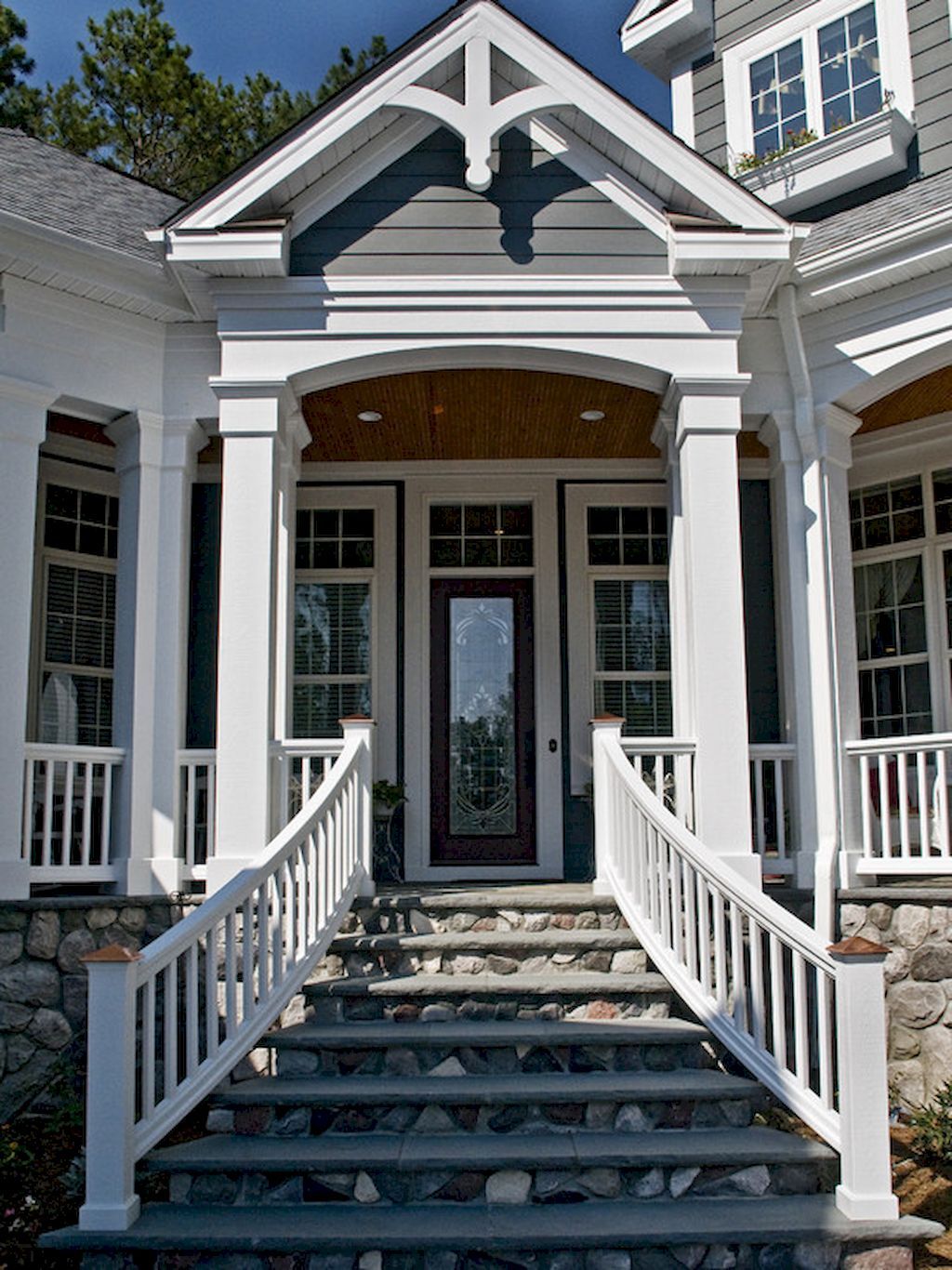Imagine stepping into a grand entrance adorned with an elegant porch and inviting steps. This comprehensive guide will equip you with the inspiration and expertise to create an entryway that exudes both warmth and style. Prepare to uncover the latest design trends, practical advice, and captivating ideas to transform your porch into a showstopper that elevates your home’s curb appeal and creates a lasting impression on visitors.
Stepping Up Your Curb Appeal: Designing with Porch Steps
First impressions matter. When it comes to your home, your porch is the first thing people see. Adding steps doesn’t just boost your curb appeal—it extends a warm welcome to guests. But before you break out the toolbox, let’s explore some fun and practical ideas to make your porch steps the envy of the neighborhood.
Design Styles: Reflecting Your Home’s Personality
Every porch, just like every house, has its own unique style. Whether your taste leans towards classic elegance or modern minimalism, there’s a porch style out there waiting to complement your home.
-
Traditional: Imagine timeless elegance—stately brick or stone steps gracing a home décor magazine. Add classic railings, perhaps with a touch of wrought iron, for a porch that whispers “sophistication.”
-
Modern: If clean lines and a “less is more” approach resonate with you, a modern porch might be your perfect match. Picture sleek metal, concrete, or composite decking for the steps, paired with minimalist railings that blend seamlessly into the design.
-
Farmhouse: Dreaming of cozy evenings and lemonade on a hot day? Farmhouse style might be your new best friend. Envision wooden steps, maybe with a fresh coat of paint on the risers, adorned with charming vintage finds or repurposed treasures.
-
Coastal: For those near the ocean (or those who simply wish they were!), a coastal porch offers the ultimate escape! Think weather-resistant materials like composite decking or painted wood in breezy, light hues.
Choosing the Right Materials: Balancing Durability and Style
Selecting the right materials for your porch steps is about more than just aesthetics; it’s about finding harmony between durability, practicality, and of course, a style that complements your budget.
-
Wood: A classic choice, wood is warm, versatile, and exudes natural charm. Keep in mind that wood requires regular staining and sealing to protect it from the elements and prevent splinters.
-
Brick: Brick steps practically scream “built to last!” They offer a timeless, traditional look and are incredibly low maintenance. Just be prepared for a potentially higher upfront cost.
-
Stone: For elegance and grandeur, it’s hard to beat stone steps. They add a touch of sophistication and can withstand almost anything Mother Nature throws their way. However, stone can be slippery when wet, so consider adding non-slip mats or treads for safety.
-
Concrete: If you’re seeking a budget-friendly and durable option, concrete is a solid contender (pun intended!). While it might not be the flashiest material, it gets the job done. Plus, you can dress up concrete steps with paint, stencils, or decorative aggregates.
-
Composite Decking: Want the look of wood without the upkeep? Composite decking, made from a blend of plastic and wood fibers, is incredibly durable, moisture and pest-resistant, and comes in various colors to suit any style. However, it may be pricier than traditional wood.
Functionality First: Safety, Accessibility, and Practicality
We all want our porches to turn heads, but they also need to be functional and safe.
-
Dimensions Matter: Before you pick up a hammer, grab your measuring tape! Building codes exist for a reason. Ensure your step height, width, and railing height meet safety guidelines and ensure accessibility for everyone.
-
Railings: Safety Meets Style: Railings are crucial for safety, especially if you have young children or older adults in your home. Choose railings that complement your porch’s design, from classic wooden balusters to sleek metal cables.
-
Let There Be Light: A well-lit porch is inviting and essential for safety after dark. Install charming lanterns, sconces, or spotlights to illuminate steps and prevent nighttime stumbles.
-
Embrace Greenery: Plants and flowers aren’t just for the garden! Strategically placed planters on your porch steps can soften hard edges and create a warm, welcoming atmosphere. Choose plants that thrive in the amount of sunlight your porch receives and won’t create tripping hazards.
Beyond the Basics: Adding those Special Touches
Ready to take your porch steps from “nice” to “WOW”? Here are a few ideas to spark your creativity:
-
Storage Solutions: Short on space? Incorporate built-in drawers or cubbies into your steps for stashing shoes, gardening supplies, or other outdoor essentials.
-
Eco-Conscious Choices: Opt for eco-friendly materials like reclaimed wood or composite decking made from recycled plastics to reduce your environmental impact without sacrificing style.
-
Landscaping Magic: Don’t neglect the area surrounding your porch steps! Integrate them seamlessly with your yard by adding colorful flower beds, lush shrubs, or a winding pathway leading up to your porch.
Porch Step Cost Breakdown: Material, Labor & Design Factors
So, you’re ready to add charming porch steps to your home? Fantastic! Before you dive in, let’s talk budget. Knowing the costs can help you plan effectively.
The price of porch steps can vary significantly, ranging from $500 on the lower end to $5,000 for more elaborate projects. Why the big difference? It all comes down to the materials, who builds them, and the complexity of the design.
1. Material Matters
-
Pressure-Treated Lumber: The “jeans and t-shirt” option. It’s affordable and gets the job done, but it might need a little extra care (like regular staining) to stay looking its best.
-
Cedar: Naturally resistant to rot, cedar is perfect for braving the elements. Of course, this durability often comes with a slightly higher price tag.
-
Composite Decking: The high-tech “athletic wear” of the decking world. It’s durable, low-maintenance, and available in a variety of styles. It’s usually the priciest option, but many find the long-term benefits worth it.
2. Labor of Love (and Money)
Unless you’re a DIY pro, you’ll probably want to hire a contractor, which will likely add between $300 to $500 to the total cost. Keep in mind that prices can vary depending on your location and the project’s complexity.
3. Design Decisions
Just like choosing a cake, a simple, elegant design will usually cost less than a multi-tiered masterpiece. Straight steps are the most budget-friendly, while curved or elaborate designs might require a larger budget.
4. DIY or Call in the Pros?
If you’re handy with tools, tackling the steps yourself can save you money. However, if you’re more comfortable leaving it to the experts, a contractor will ensure a polished look and efficient construction.
In a Nutshell
Figuring out the cost of your dream porch steps doesn’t have to be a guessing game. By considering materials, labor, and design, you can create a realistic budget. It’s always wise to get quotes from a few contractors to compare options.
How to Build Front Porch Steps: A DIY Guide for Beginners
You’ve got your front porch, but it needs a little something extra. Adding a step or two can make a world of difference! Let’s break down how to tackle this project, ensuring it’s sturdy, safe, and adds a touch of charm to your home.
Planning for Success
Before grabbing your tools, let’s map things out.
- Material Selection: Do you envision classic wood, modern concrete, or something else?
- Design Dreams: Is your porch sprawling or compact? The design of your steps should complement its style.
- Building Codes: Check with your local building department to see what permits you might need.
Gathering Your Gear
- Cutting Tools: A circular saw and a miter saw will help you make precise cuts.
- Assembly Tools: You’ll need a drill and a hammer for attaching components.
- Leveling Tools: A level ensures your steps are even, and a measuring tape is essential for accurate dimensions.
If you’re using concrete, you’ll also need:
- Pressure-treated lumber: For building the forms.
- Concrete mix: Choose a good quality mix from your local hardware store.
- Rebar: These metal rods add strength to the concrete.
- Gravel and Sand: These create a stable base for your steps and aid in drainage.
Building Your Steps
- Plan (Again!): Determine how many steps you want, their width and depth, and ensure everything aligns with your porch.
- Permits: Get any necessary permits.
- Excavation: Dig out an area for your steps, ensuring it’s deep enough for a stable base.
- Foundation: Fill the excavated area with gravel for drainage and a level surface.
- Forms (for Concrete): Build forms to hold the wet concrete in place as it dries.
- Pouring Concrete: Carefully pour the concrete mix into the forms, ensuring even distribution.
- Finishing Touches: Once the concrete is dry, remove the forms and add any finishing touches.
Thinking Long-Term
- Weather Resistance: If you live in an area with extreme weather, choose durable materials.
- Maintenance Matters: Regular cleaning and resealing (for wood) will help your steps last for years.
Weighing the Pros and Cons
Pros:
- Accessibility: Steps can make your porch more approachable.
- Curb Appeal: Well-designed steps boost your home’s charm.
- Outdoor Living: Steps create a seamless transition between your porch and yard.
Cons:
- Cost: Adding steps can be a significant investment.
- Maintenance: Steps require regular upkeep.
- Safety: Steps can be a tripping hazard. Adding railings and non-slip surfaces can mitigate these risks.
Adding steps to your front porch can transform your home’s look and feel. With careful planning and execution, you’ll have a beautiful and functional entrance you’ll love for years to come.
The Complete Guide to Porch Step Dimensions: Size, Code & Comfort
You’ve got the vision for your dream porch steps; now, let’s make sure they’re both safe and stylish. It’s about finding the sweet spot where your steps are comfortable to climb and meet building codes.
Understanding the Basics
- Tread Depth: The part you step on. Aim for 10-12 inches for comfortable foot placement.
- Riser Height: The vertical part of the step. A height of 7-8 inches is standard.
- Step Width: For a welcoming entryway, aim for a width of at least 48 inches.
Remember to check your local building codes, as they often outline specific minimum safety standards for step dimensions.
Calculating the Number of Steps
- Measure the Total Rise: The vertical distance from the ground to the porch surface.
- Choose a Riser Height: Select a comfortable riser height within the code-compliant range (e.g., 7.5 inches).
- Divide and Round Up: Divide the total rise by the chosen riser height, rounding up to the nearest whole number to determine the number of steps.
Building Codes and Safety
- Consult Your Local Codes: Regulations vary, so always double-check for specific requirements in your area.
- Handrails: Typically required for stairs with more than 2-3 steps.
- Lighting: Adequate lighting is crucial for nighttime safety.
Design and Aesthetics
While safety comes first, your porch steps should also reflect your style. Consider different materials like wood, concrete, or stone, and don’t be afraid to get creative with the design!
By following these guidelines and adding your own personal touch, you’ll create porch steps that are both beautiful and functional!
- How to Remove Water Stains from Fabric: A Complete Guide - April 26, 2025
- How to Get Motor Oil Out of Clothes: Proven Methods & Expert Tips - April 26, 2025
- How to Get Deodorant Out of Black Shirts: Easy Stain Removal Guide - April 26, 2025










